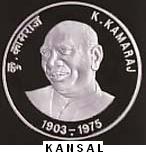 |
 |
 |
 |
 |
 |
 |
 |
 |
 |
 |
 |
 |
 |
 |
 |
 |
 |
 |
 |
 |
 |
 |
 |
 |
 |
 |
 |
 |
 |
 |
 |
 |
 |
 |
 |
 |
 |
 |
 |
 |
 |
 |
 |
 |
 |
 |
 |
 |
 |
 |
 |
 |
 |
 |
 |
 |
 |
 |
 |
 |
 |
 |
 |
|
|
Commemorative Coins on K Kamraj (2003) |
|
|
|
 |
|
|
 |
|
|
|
|
|
|
Back Face |
|
|
Front Face |
|
|
|
|
|
|
DETAILS OF COINS : |
|
|
|
|
|
|
|
Composition |
|
|
|
|
Denomination |
|
|
|
|
Weight |
|
Shape |
|
Size dia |
|
|
|
|
|
|
|
|
|
|
|
|
|
Rs.100/- |
|
Quaternary alloy, Silver 50%,Copper 40%, Nickel 5%, Zinc 5% |
|
|
|
35 gms |
|
44 mm |
|
|
|
|
|
Circular |
|
|
|
|
|
|
|
|
|
|
|
|
|
|
|
Rs. 5/- |
|
9 gms |
|
|
|
|
23 mm |
|
Cupro Nickel Alloy, Copper 75%, Nickel 25% |
|
|
|
|
Circular |
|
|
|
|
|
|
|
|
|
|
|
|
|
|
 |
|
|
|
|
|
|
 |
|
|
|
|
|
Postage Stamp on Kamaraj |
|
|
|
|
Kamaraj with Pt Nehru |
|
|
|
|
|
|
A short introduction of Kamraj |
|
|
Early Years |
|
|
|
|
|
|
K. Kamaraj, was born on 15 July 1903 in a backward tract of Tamilnadu, India. His father died when he was only six. He was barely fifteen when he heard of the JallianwalaBagh massacre by British which was the decisive turning point in his life, two years later when Kamaraj saw Gandhiji at Madurai, the path was chosen. He became a member of the Indian National Congress.
Kamaraj was eighteen when he responded to the call of Gandhiji for non-cooperation with the British. At twenty Kamaraj was picked up by S. Satyamurthy, one of the greatest and a leading figure of the Tamilnadu Congress Committee, who was to be Kamaraj?s political guru. |
|
|
|
In April 1930 Kamaraj joined the Salt Satyagraha Movement at Vedaranyam and was sentenced to two years, his first term in prison. Jail going had become a part of his career, and in all he had been to prison six times and spent more than 3,000 days in British Jails. Bachelor Kamaraj was forty-four when India became free. |
|
|
|
As Chief Minister of Madras |
|
|
|
Kamaraj was elected to the Madras Legislative Assembly several times. He was also elected to the Constituent Assembly of India in 1946, and later to the Parliament in 1952. He became Chief Minister of Madras in 1954. It was during the nine years of his administration that Tamilnadu came to be known as one of the best administered States in India. |
|
|
|
Kamraj Plan |
|
|
|
In 1963 Kamaraj suggested to Prime Minister JawaharLal Nehru that senior, Congress leaders should leave ministerial posts to take up organisational work. This suggestion came to be known as the Kamaraj Plan, which was designed primarily to dispel from the minds of Congressmen the lure for power.� The plan was approved by the Congress Working Committee and was implemented within two months. Six Chief Ministers and six Union Ministers resigned under the Plan. |
|
|
|
Kamaraj was elected President, Indian National Congress, on 9 October 1963. Twice he played a leading role in choosing the Prime Minister of India. |
|
|
|
Main Page |
|


